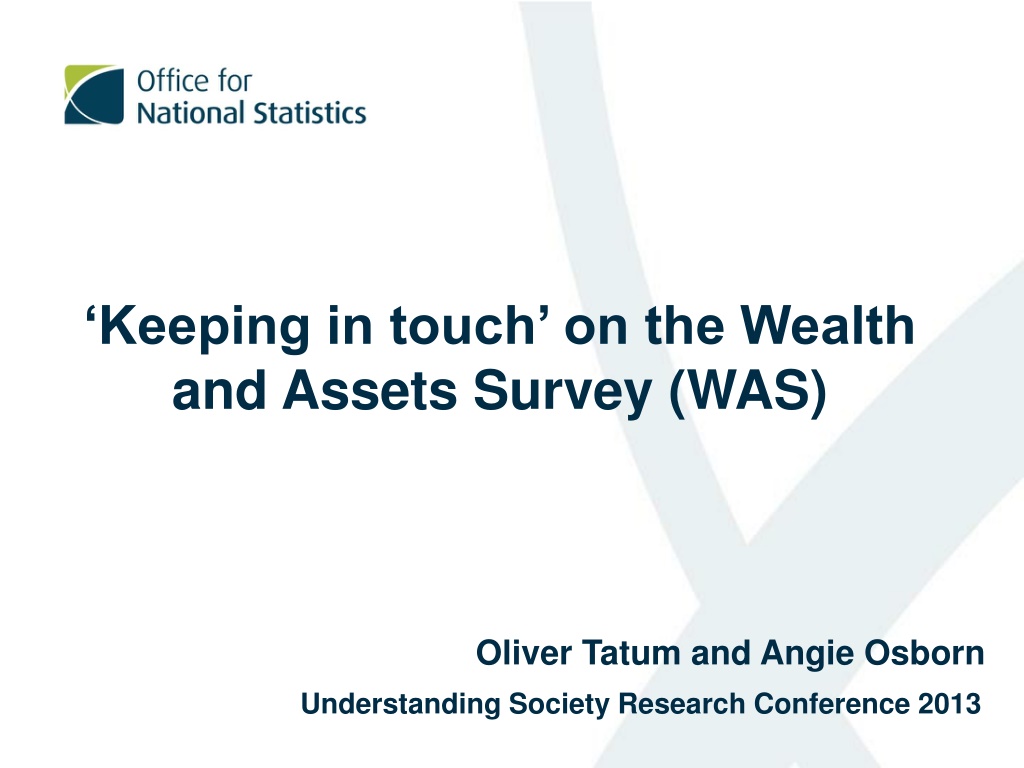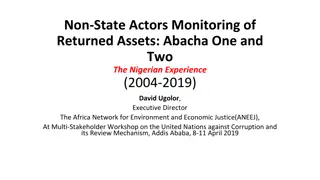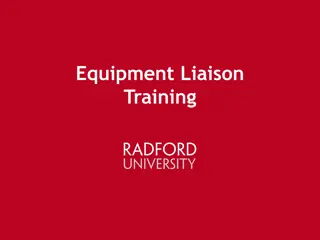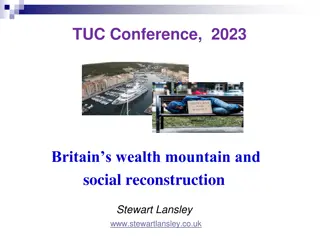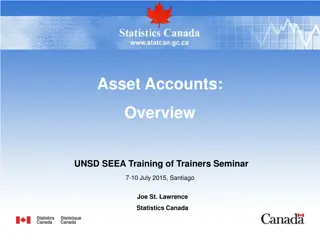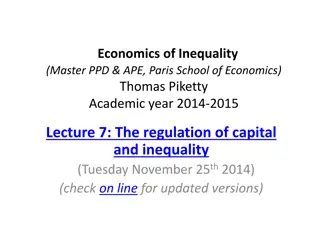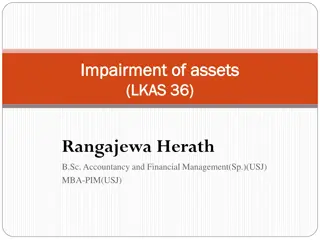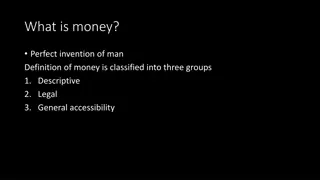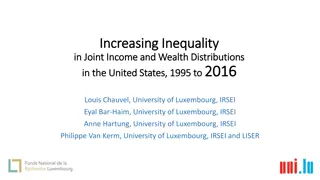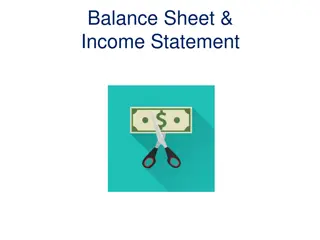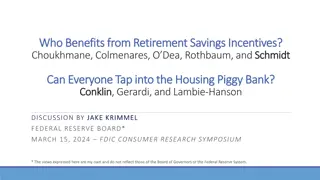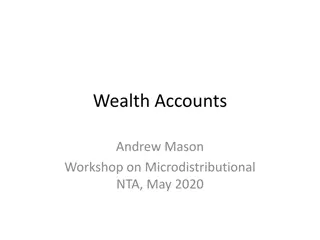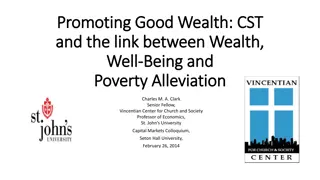Understanding Society: Wealth and Assets Survey Research
The Wealth and Assets Survey (WAS) conducted by Oliver Tatum and Angie Osborn at the Understanding Society Research Conference in 2013 focuses on longitudinal issues, experiment design, research findings, and future plans related to the survey. The WAS background includes collecting data on personal savings, assets, debt, retirement savings, financial advice, and attitudinal aspects. Survey topics cover various types of wealth including property, physical, and financial assets, as well as liabilities such as loans and pensions. The survey design involves a random sample stratified by postcode, with households in Great Britain participating through Computer Assisted Personal Interviewing (CAPI). Re-interviews are conducted every two years to track changes over time. Media coverage and the distribution of total household wealth in Great Britain in 2008/10 are also discussed.
Download Presentation

Please find below an Image/Link to download the presentation.
The content on the website is provided AS IS for your information and personal use only. It may not be sold, licensed, or shared on other websites without obtaining consent from the author. Download presentation by click this link. If you encounter any issues during the download, it is possible that the publisher has removed the file from their server.
E N D
Presentation Transcript
Keeping in touch on the Wealth and Assets Survey (WAS) Oliver Tatum and Angie Osborn Understanding Society Research Conference 2013
Outline WAS background Longitudinal issues Experiment design Research findings Future plans Questions
WAS background Wealth & Assets Survey (WAS) Longitudinal survey of private households in GB All adults over 16 years (excluding 16-18 year olds in FT education) Consortium of government departments Collects data on: a) value of all personal savings, assets and debt; b) level of saving for retirement; c) financial advice: frequency and types received; d) attitudinal (attitudes to saving, financial acuity, wellbeing, health)
WAS background: Survey topics Property wealth House value minus Mortgage values Other Property Buy to let/ 2nd homes (incl. Overseas) Physical wealth Vehicles, House contents and Collectables Financial wealth Assets: Current / Savings/ Investment accounts/ Shares/ Trusts Liabilities: Loans / Credit Cards/ Store cards/ Mail order/ HP Pension wealth Employer sponsored & Individual Personal pensions Retained pensions (previous employment) Pension from a Spouse or Partner (current or former)
Distribution of Total Household Wealth, Great Britain, 2008/10
WAS background: Survey design Random sample, stratified by Postcode Royal Mail Postcode Address File (PAF) Wealthiest 10% Postcodes over-sampled (3:1) All private households in GB (excl. north of Caledonian Canal, the Scottish Islands and the Islesof Scilly) Computer Assisted Personal Interviewing (CAPI) Responses weighted using census data to allow results to be generalised to GB population
WAS background: Survey design Re-interview households every two years Follow original sample members to new addresses Wave 1 Wave 2 Wave 3 Wave 4 Year 1 Year 2 Year 1 Year 2 Year 1 Year 2 Year 1 Year 2 July 06 June 08 July 08-June 10 July 10-June 12 July 12-June 14 Keeping In Touch Exercise telephone (KITE) 4 months (previously 3 months) before follow up
WAS background: Survey design Wave 1 62,400 households sampled 55,829 households eligible 30,595 achieved household interviews Wave 2 Wave 1 respondents re-interviewed Wave 1 non-contacts re-attempted 20,170 achieved household interviews Wave 3 & Wave 4 Wave 1&2 respondents re-interviewed Wave 2&3 non-contacts & soft refusals re-attempted New panel boost : 12,000 new addresses in wave 3 16,000 new addresses in wave 4
Longitudinal issues Attrition: Maintaining WAS longitudinal sample over time by maximising response at next wave Tracking: Accurately tracking WAS original sample members who move address (local/distant) between waves Engagement: Keeping respondents interested in & engaged with WAS over time
Longitudinal issues: Current measures Anticipatory: various contact details collected nominated persons contact details likelihood of moving in the next year checked respondent change of address cards incentives for participation Between wave: telephone keep in touch exercise (KITE) UK address changes service In wave: interviewers trace local movers in the field pre-paid respondent letter left with old address distant movers reissued to another interviewer
Longitudinal issues Attrition: Maintaining WAS longitudinal sample over time by maximising response at next wave Tracking: Accurately tracking WAS original sample members who move address (local/distant) between waves Engagement: Keeping respondents interested in & engaged with WAS over time Value for money: Using resources required to address these issues as efficiently/effectively as possible
Aims of the Experiment To measure the impact of two KITE methods on response rates for field work To establish the best timing for issuing survey newsletters to respondents To measure the effectiveness of two KITE methods to identifying eligible and ineligible movers To provide supporting information to make an informed decision about the cost- effectiveness of assessed treatments.
Experiment Design (1) KITE + KITE Newsletter KITE KITE No Newsletter treatment
Experiment Design (2) KITE Interview Newsletter 2-page leaflet Easy-to-read graphs Media headlines and user feedback Highlighting importance to participate Contact details ~ 5 min CAPI interview 4 months before field interview Up-date on household composition and contact details
Experiment Design (3) Mainstage Month HAS1011 HAS1012 HAS1101 07/10 08/10 09/10 10/10 11/10 12/10 01/11 02/11 03/11 04/11 05/11 06/11 07/11 08/11 09/11 10/11 11/11 12/11 01/12 02/12 HAS1103 HAS1104 HAS1105 HAS1106 HAS1107 HAS1108 HAS1109 HAS1110 HAS1111 HAS1112 HAS1201 HAS1202 Newsletter posted HAK interview HAS mainstage interview
Hypothesis testing 1. H0: The individual s field interview outcome is independent from the experiment group 2. H0: The individual s field interview outcome is independent from the length of time between posting the newsletter and the field interview 3. H0: The resident status at the field interview is independent from the experiment groups
Hypothesis Testing (1) H0: The individual s field interview outcome is independent from the experiment group. Experiment Group Interview Outcome 1 2 1 3 1 4 Response N Column % N Column % N Column % N Column % N Column % Design DF Pearson's Chi2 F-Statistic P-value 3,228 65.3 1,162 23.5 358 7.2 197 4.0 4,945 100.0 3,027 65.5 1,114 24.1 317 6.9 164 3.6 4,622 100.0 951 1.963 0.337 3,228 65.3 1,162 23.5 358 7.2 197 4.0 4,945 100.0 3,150 65.6 1,127 23.5 300 6.3 224 4.7 4,801 100.0 953 6.692 1.190 0.312 3,228 65.3 1,162 23.5 358 7.2 197 4.0 4,945 100.0 3,058 68.0 1,006 22.4 266 5.9 169 3.8 4,499 100.0 954 10.676 2.116 0.097 Non-response (non- contact/ refusal) Unknown eligibility Ineligible Total 0.797
Hypothesis Testing (2) H0: The individual s field interview outcome is independent from length of time between posting the newsletter and interview. No. of months between NL and W3 Interview Outcome 4 5 6 7 8 9 Response N Column % N Column % N Column % N Column % N Column % Design DF Pearson's Chi2 F-Statistic P-value 1,085 67.4 361 22.4 117 7.3 1,028 65.7 354 22.6 116 7.4 1,044 66.6 341 21.8 123 7.8 1,029 66.9 364 23.7 875 66.6 316 24.1 82 6.3 40 3.1 1,313 100.0 1,024 67.0 384 25.1 Non-response (non- contact/ refusal) Unknown eligibility 86 5.6 59 3.8 59 3.9 61 4.0 Ineligible 46 2.9 67 4.3 60 3.8 1,609 100.0 1,565 100.0 1,568 100.0 1,538 100.0 1,528 100.0 936 38.418 1.278 0.209 Total
Hypothesis Testing (3) H0: The resident status is independent from the experiment groups. Type of Mover Experiment Group 1 2 1 3 1 4 Non-mover - contact/ eligible N Column % N Column % N Column % N Column % N Column % Design DF Pearson's Chi2 F-Statistic P-value 4,139 83.7 177 3.6 3,928 85.0 130 2.8 4,139 83.7 177 3.6 3,955 82.4 136 2.8 186 3.9 524 10.9 4,801 100.0 953 56.591 4,139 83.7 177 3.6 3,790 84.2 134 3.0 140 3.1 435 9.7 4,499 100.0 954 35.722 6.511 Non-mover - non- contact/ eligible Mover - eligible 74 1.5 555 11.2 4,945 100.0 83 1.8 481 10.4 4,622 100.0 951 7.516 1.430 74 1.5 555 11.2 4,945 100.0 74 1.5 555 11.2 4,945 100.0 Mover - ineligible/ unknown Total 10.321 0.232 0.000 0.000
Summary (1) H0: The individual s field interview outcome is independent from the experiment group KITE and newsletter together do have some positive effects on response at the field stage
Summary (2) H0: The individual s field interview outcome is independent from the length of time between posting the newsletter and the field interview This test did not show any conclusive evidence on the best time to post newsletters
Summary (3) H0: The resident status at the field interview is independent from the experiment groups The KITE interviewer does have an effect on the identification of movers
Conclusion Continue KITE interviews positive impact on identifying movers and tracing them at new location Consider introduction of periodical newsletters positive impact on response rates in combination with KITE interviews
Future plans Attrition and response measures: Introduce mailed out newsletter for previous respondents Introduce key WAS results factsheet for field interviewers Email KITE for telephone KITE non-contacts Incentives testing: unconditional 5 voucher with advance letter for boost addresses (Apr Sep 2013) WAS outputs: WAS Wave 3 results scheduled December 2013 Wave 5 development Wave 5 pilot in October 2013 Wave 5 launch scheduled for July 2014
Questions / Comments? Oliver Tatum oliver.tatum@ons.gsi.gov.uk Angie Osborn angie.osborn@ons.gsi.gov.uk
